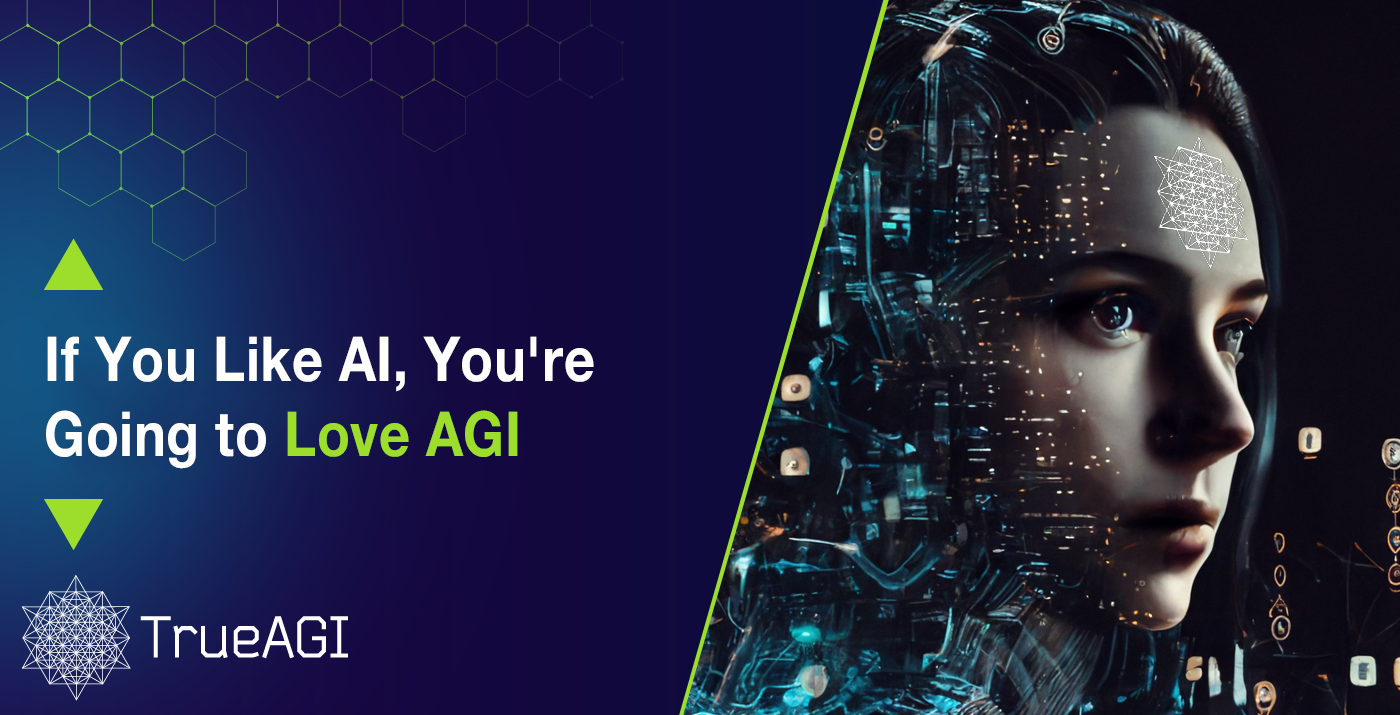
Key differences between artificial intelligence (AI) and artificial general intelligence (AGI)
Artificial intelligence has become an integral part of our daily lives. It has revolutionized industries and transformed the way we interact with technology. And yet, we haven’t even seen its true potential yet.
Indeed, there’s an even more exciting advancement on the horizon that promises to take AI to new heights: artificial general intelligence (AGI). Not only will this technology make current AI models seem outdated, it also has the most transformative potential since the internet.
In this article, we’ll tell you everything you need to know about AGI, how it is different from AI, and why it matters.
What Is Artificial Intelligence (AI)?
AI refers to the development of computer systems that can perform tasks that would typically require human intelligence.
These systems are designed to analyze vast amounts of data, recognize patterns, and make decisions or predictions based on different types of inputs.
Although it has risen in popularity recently, AI is nothing new. In fact, various businesses are already using it. Whenever you log into your Netflix account, for example, the recommendations you receive on what to watch next are generated by artificial intelligence. Netflix “remembers” what shows you watched and liked, cross-references the labels those shows have been assigned, and recommends those with similar characteristics.
But how do these AI models actually do that? Here’s a simplified explanation of how AI works:
- Data Collection: Machines gather information from various sources, like sensors, databases, or the internet.
- Learning: AI systems use algorithms to analyze the collected data and identify patterns or relationships within it.
- Training: The AI system is “trained” by its developers, who provide it with labeled examples. It learns from these examples to recognize patterns and make predictions.
- Decision-Making: Once trained, the AI system can use its knowledge to make decisions or predictions when presented with new, unseen data by recognizing patterns within it that match the ones it’s been trained on.
Limitations of Artificial Intelligence
Modern large language models (LLMs) like ChatGPT or Google Bard can answer almost anything you ask them. They are trained with massive data models, which allows them to recognize almost every existing word in many different languages.
Now, when you “talk” with these AI models, they don’t really “understand” what you tell them. Instead, what they do is recognize the words you used and perform countless complex computations based on the probability of words appearing after another. Then, it produces a response according to the results of those calculations.
In short, this means that these LLMs don’t have the capacity to understand either what you tell them or what they respond to you. It’s merely a matter of math and probability. And while they are still capable of producing amazing results, they are also limited as to the depths of their applications.
This is why these “narrow” AI models don’t do very well when it comes to subjective matters or exceptional situations. For example, if you ask ChatGPT about the best movie ever made, it would likely answer something similar to:
“Determining the “best” movie ever made is subjective and often varies from person to person based on individual preferences, tastes, and cultural backgrounds.”
At the same time, this limitation is a major barrier for AI to be used for more advanced applications like healthcare or education. These fields require a deeper, dedicated approach tailored to each individual’s particular characteristics, necessities, and personal situation; rather than a general response based on big data.
Artificial intelligence models can help us save time and resources solving small problems. Yet, in order to truly transform the way we live, we need to bring it to the next level. Here’s where artificial general intelligence comes in.
What Is Artificial General Intelligence (AGI)?
Artificial general intelligence (AGI) refers to systems that will be able to understand what they are told and use logic, reasoning, and inference to produce a response.
More specifically, AGI aims to teach a system to learn and think like humans—not just make decisions like humans. While AI provides a set of parameters for making the best decision, AGI is capable of performing thought and cognitive processes that allow it to approach tasks in the same way that humans do.
How, exactly? By developing systems that can understand, learn, and apply knowledge across a wide range of domains, making them adaptable and capable of handling diverse tasks. In other words, AGI has the ability to generalize—hence the term—and transfer knowledge across different aspects.
How AGI Can Generalize Knowledge
Imagine you’re training an AI system to identify different types of vehicles. So, you load several pictures of different cars, vessels, and aircrafts from different angles.
This system may be able to recognize these vehicles in different pictures or videos, but even after its training, it doesn’t really know the concept of “cars,” “aircrafts” or “vessels.”
Now, imagine it comes across a picture of an amphibious car, which is a type of vehicle it wasn’t trained on. As a consequence, the system may miscategorize it or fail to identify it altogether.
AGI works on a different level. Instead of training it to recognize specific elements, an AGI system can be trained on the notions of these different types of vehicles beyond what they look like. They can understand these general concepts, and are capable of reasoning and combining them together to identify them, just like your brain does.
In other words, this means that AGI:
- Has a greater understanding of reality and how it works. It can generalize knowledge from diverse domains and identify patterns to perform actions beyond its training data.
- This allows it to perform complex, multi-step reasoning and inference processes, taking multiple factors into account simultaneously.
- The ability to carry out these cognitive tasks just like the human brain does enables AGI systems to possess genuine creativity and inventiveness.
Core Differences Between AI and AGI
Before we jump into comparisons, it’s important to note that artificial general intelligence remains a concept. Although there are frameworks and mechanisms in place that bring us ever closer to it, we haven’t been able to develop such a technology—yet.
There are many differences between artificial intelligence as it is today and AGI in terms of architecture and functioning, but the most relevant distinction lies within their capabilities.
AI systems are designed for specific tasks—in which they excel at—within predefined parameters. Now, even though these tasks are becoming more complex as the technology advances, there is still one critical limitation: these AI systems lack the flexibility and versatility to generalize knowledge across domains.
In contrast, AGI seeks to create machines that possess the cognitive abilities to learn and apply knowledge to various tasks, just like humans do.
More specifically, AGI aims to achieve the following capabilities that go beyond AI:
- Common sense reasoning: AGI systems should be able to understand and reason about the world, making logical deductions, and drawing conclusions based on the available information.
- Contextual understanding: Similarly, these systems should possess the ability to understand context and use that understanding to interpret ambiguous situations and make appropriate decisions where mere data isn’t enough.
- Adaptive learning: AGI should be able to learn from new experiences, acquire new skills, and self-improve its performance over time without relying solely on pre-programmed instructions. In other words, it should be able to “make a leap into the unknown,” exploring new domains on its own.
The Next Level of Artificial Intelligence
These augmented capabilities are prone to unlock the true potential of artificial intelligence as a whole, making AGI one of the most revolutionary technologies in history. But it won’t be easy to achieve.
In this regard, TrueAGI is committed to leverage the OpenCog Hyperon development framework to accelerate the development of artificial general intelligence and create tailored AGI solutions for businesses and enterprise organizations.
AGI will be a powerful technology, and as such, it should be available for everyone and at the service of humanity. It is TrueAGI’s mission to make that happen.

Subscribe to our Newsletter
Email Address